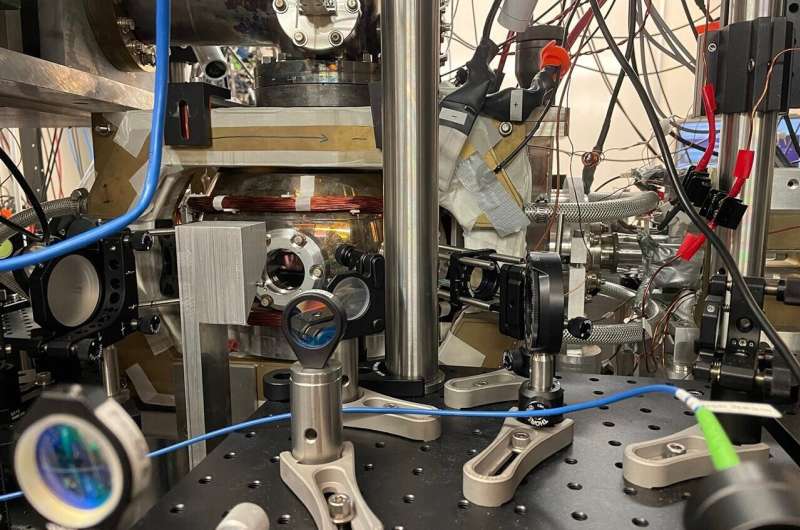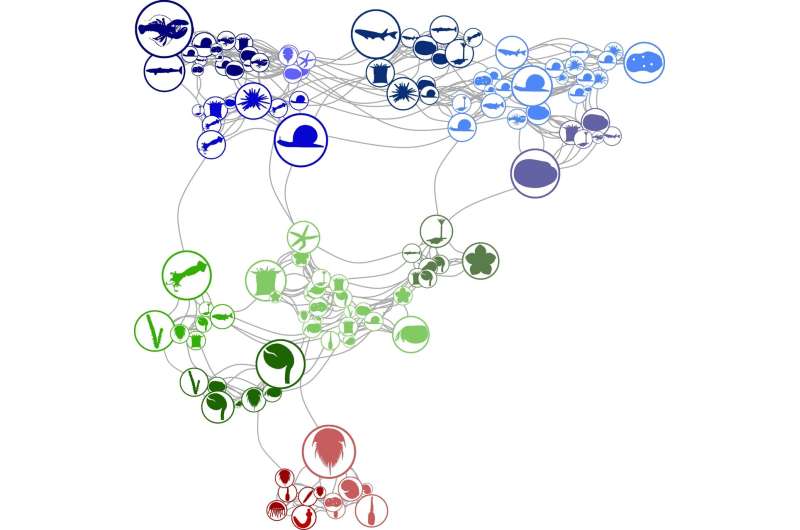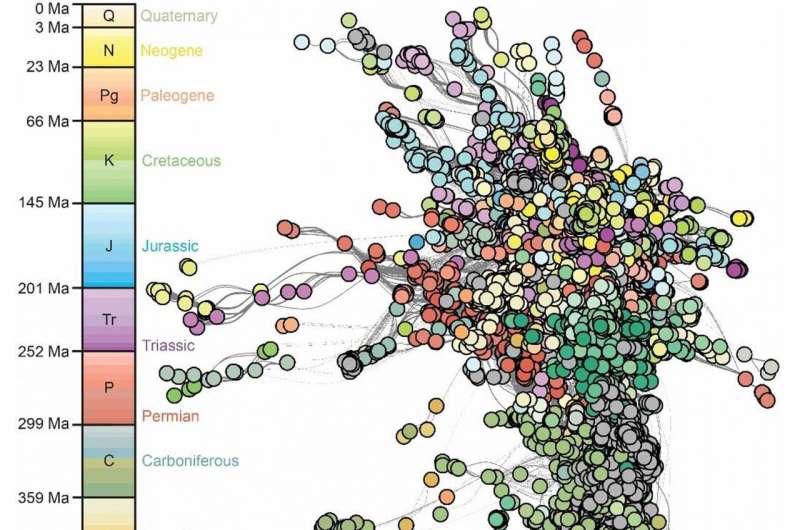A new way to control atomic interactions

In a new study, Stanford researchers demonstrate how to manipulate atoms so they interact with an unprecedented degree of control. Using precisely delivered light and magnetic fields, the researchers programmed a straight line of atoms into treelike shapes, a twisted loop called a Möbius strip and other patterns.
These shapes were produced not by physically moving the atoms, but by controlling the way atoms exchange particles and "sync up" to share certain properties. By carefully manipulating these interactions, researchers can generate a vast range of geometries. Importantly, they found that atoms at the far ends of the straight line could be programmed to interact just as strongly as the atoms located right next to each other at the center of the line. To the researchers' knowledge, the ability to program nonlocal interactions to this degree, irrespective of the atoms' actual spatial locations, had never been demonstrated before.
The findings could prove a key step forward in the development of advanced technologies for computation and simulation based on the laws of quantum mechanics—the mathematical description of how particles move and interact on the atomic scale.
"In this paper, we've demonstrated a whole new level of control over the programmability of interactions in a quantum mechanical system," said study senior author Monika Schleier-Smith, the Nina C. Crocker Faculty Scholar and associate professor in the Department of Physics in Stanford's School of Humanities and Sciences. "It's an important milestone that we've long been working towards, while at the same time it's a starting point for new opportunities."
The study published Dec. 22 in the journal Nature.
Two graduate students, Avikar Periwal and Eric Cooper, as well as a postdoctoral scholar, Philipp Kunkel, are co-lead authors of the paper. Periwal, Cooper and Kunkel are researchers in Schleier-Smith's lab at Stanford.
"Avikar, Eric and Philipp worked tremendously well together as a team in running the experiments, devising clever ways of analyzing and visualizing the data and developing the theoretical models," said Schleier-Smith. "We're all very excited about these results."
"We chose some simple geometries, like rings and disconnected chains, just as proof of principle, but we also formed more complex geometries including ladder-like structures and treelike interactions, which have applications to open problems in physics," Periwal, Cooper and Kunkel said in a group statement.
Syncing up atoms on command
Periwal, Cooper, Kunkel and colleagues performed experiments for the study on apparatuses known as optical tables, a pair of which dominate the floorspace in Schleier-Smith's lab. The tables are inset with intricate arrays of electronic components strung together by multicolored wires. At the heart of one optical table is a vacuum chamber, consisting of a metallic cylinder studded with porthole windows. A pump expels all air from this chamber so that no other atoms can disturb the small bunches of rubidium atoms carefully placed inside it. The Stanford researchers beamed lasers into this airless chamber to trap the rubidium atoms, slowing the atoms' movement and cooling them down to within whiskers of absolute zero—the lowest temperature theoretically possible where particle movement comes to a virtual standstill. The extremely cold realm just above absolute zero is where quantum mechanical effects can dominate over those of classical physics, and thus where the atoms can be quantum mechanically manipulated.
Shining light through the bunches of atoms in this way also serves as a means of getting the atoms to "talk" to each other. As the light strikes each atom, it conveys information between them, generating patterns called "correlations" wherein every atom shares a certain desired quantum mechanical property. An example of a quantum mechanical property is the total angular momentum, known as the spin of an atom and which can have values of, for example, +1, 0 or –1.
Researchers at Stanford and elsewhere have correlated atomic networks before using systems of laser-cooled atoms, but, until recently, only two basic kinds of atomic networks could be made. In one, called an all-to-all network, every atom talks to every other atom. The second kind of network operates on what's known as a nearest neighbor principle, where laser-suspended atoms interact most strongly with adjacent atoms.
In this new study, the Stanford researchers debut a far more dynamic method that conveys information over specific distances between discrete groups of atoms. This way, spatial location does not matter, and a vastly richer set of correlations can be programmed.
"With an all-to-all network, it's like I'm sending a worldwide bulletin to everyone, while in a nearest-neighbor network, it's like I'm only talking to the person who lives next door," said Schleier-Smith. "With the programmability that we have now demonstrated in our lab, it's like I'm picking up a phone and dialing the exact person I want to talk to located anywhere in the world."
The researchers succeeded in creating these nonlocal interactions and correlations by controlling the frequencies of light shone at the trapped bunches of rubidium atoms and varying the strength of an applied magnetic field in the optical table. As the magnetic field strengthened in intensity from one end of the vacuum chamber to the other, it caused each bunch of atoms along the line to spin a bit faster than the prior, neighboring bunch. Although each atomic bunch had a unique rotation rate, every so often, certain bunches would nonetheless periodically arrive at the same orientation—rather like how a row of clocks with progressively faster-spinning hands will still momentarily read off the same times. The researchers used light to selectively enable and measure interactions between these momentarily synced-up atomic clouds. Overall, using a straight line of 18 clouds of atoms, the researchers could generate interactions between clouds at any specified set of distances along the line.
"The ability to generate and control these kinds of nonlocal interactions is powerful," Schleier-Smith added. "It fundamentally changes the way information can travel and the quantum systems we can engineer."
Benefitting from versatile control
One of the many applications of the Stanford team's work is the crafting of optimization algorithms for quantum computers—machines that rely on the laws of quantum mechanics for crunching numbers. Quantum computing has applications in artificial intelligence, machine learning, cybersecurity, financial modeling, drug development, climate change forecasting, logistics and scheduling optimization. For example, quantum computer-tailored algorithms could efficiently solve scheduling problems by finding the shortest possible routes for deliveries, or optimal scheduling of university classes so the greatest number of students can attend.
Another highly promising application is testing out theories of quantum gravity. The treelike shapes in this study were expressly designed for this purpose—they serve as basic models of space-time curved by a hypothetical new concept of gravity based on quantum mechanical principles that would revamp our understanding of gravity as described in Albert Einstein's theory of relativity. A similar approach can also be applied to investigate the light-trapping, ultra-dense cosmic objects called black holes.
Schleier-Smith and colleagues are now working on showing that their experiments can produce quantum entanglement, where quantum states among atoms are correlated in a manner that can be harnessed for applications ranging from ultraprecise sensors to quantum computation.
"We made a lot of progress with this study and we're looking to build on it," said Schleier-Smith. "Our work demonstrates a new level of control that can help bridge the gap, in several areas of physics, between elegant theoretical ideas and actual experiments."Chaining atoms together yields quantum storage
More information: Avikar Periwal et al, Programmable interactions and emergent geometry in an array of atom clouds, Nature (2021). DOI: 10.1038/s41586-021-04156-0
Journal information: Nature
Provided by Stanford University




